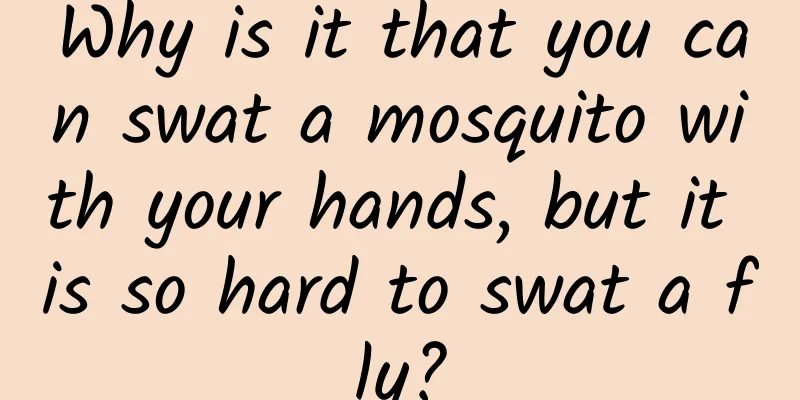Why is it that you can swat a mosquito with your hands, but it is so hard to swat a fly?

|
Review expert: Jiang Tao, Vice Chairman of the Science Popularization Committee of the Chinese Society for Bioengineering SUMMER We often encounter this situation: on a hot summer day, mosquitoes buzz in our ears and we can easily slap them to death. However, when it comes to flies, even though they look bigger and more obvious, we often have trouble hitting them. There are actually some interesting biological and physical principles behind this. Let's talk about it today~ Flies have wide field of vision with their compound eyes Humans have two eyes located in front of their heads, each with a complete retinal imaging system, known as a monocular vision system. However, many insects and arthropods, including flies, have a pair of huge compound eyes that take up a large area of their heads. Each compound eye is composed of several ommatidia. For example, the compound eyes of houseflies are composed of up to 4,000 hexagonal ommatidia, and each ommatidia is an independent imaging system. Image source: Qianku.com Compared with human eyes, each ommatidium in a compound eye has a relatively simple imaging system. The compound eye vision formed by the superposition of ommatidia is more like a mosaic picture , with low pixels and poor picture resolution. Although compound eyes have poor imaging capabilities, they are extremely sensitive to changes in light and shade . Each eye can respond to changes in light and shadow at a very high frequency in a very short time. A normal person's eyes can distinguish 24 pictures per second (this is also the lowest speed of cartoons), while insect compound eyes can distinguish about 240 pictures. When looking at fast-moving objects, it only takes 0.01 seconds to quickly distinguish the shape, size, relative position and distance of the object. In addition, **the field of view of the compound eyes is relatively wide, and the compound eyes of flies can almost see objects within a 360 -degree range. **No matter which direction you ambush, the fly can find you with its compound eyes. Flies take off quickly In addition to compound eyes, another important reason why we can't hit flies is that they take off too fast ! Common flies belong to the petal flies, which take off faster than other flies. The take-off process takes an average of only 7.34 milliseconds , while it takes 300 milliseconds for a human to blink . You can imagine how fast a fly takes off. Image source: Qianku.com Entomologists have found that flies only use a pair of front wings to fly,** and their hind wings have degenerated into dumbbell-shaped balance bars,** but this is not a useless organ. The ability of petal flies to take off quickly and stably is related to this sensory organ called the "balance bar". When a fly is flying, the balance bar will vibrate at a high frequency of 300 times per second. When the fly turns or tilts during flight, the root of the balance bar can sense the change and transmit it to the fly's brain, thereby balancing the body and correcting its course. If this organ of the fly is damaged, it will significantly reduce their takeoff speed and stability. The balance bar is a good navigation tool for flies when flying. When the fly is still, it will also vibrate the balance bar regularly. This regular vibration is like a warm-up exercise, allowing the fly to take off at any time. Just like a car waiting for the green light at a traffic light intersection, the engine is not turned off, and as soon as the green light comes on, it can start driving quickly. **Scientists developed a gyroscope based on the navigation principle of a fly balance stick,**which solved the problem of aircraft rolling and tilting when flying at high speed. Now gyroscopes have been widely used in fields such as navigation, aerospace, and military. Why can a fly swatter catch flies? The reason why a fly swatter can successfully hit a fly is ultimately due to one word: fast . In the design of a fly swatter, the long handle plays a key role. The long handle brings a long lever arm, making the swing speed faster. Even an untrained person can easily swing a fly swatter at a speed of 80m/s. This high-speed swing causes the fly to be hit quickly before it has time to react. The holes in the swatter also play a role. These holes reduce air resistance, which further increases the swatter's speed. However, this is not the determining factor. **To verify this, you can try a simple experiment: **Break the handle of the fly swatter and use the swatter head to hit the fly directly. You will find that it is still difficult to hit the target; on the contrary, if you seal the small hole on a good fly swatter with tape, although the success rate will decrease, you will still be able to hit the fly successfully most of the time. This shows that the decisive factor is the speed of the end of the fly swatter. Why can we smack mosquitoes with our hands? Blood-sucking mosquitoes are our biggest enemy. In history, more people have died from diseases spread by mosquitoes than from wars. Compared with flies, mosquitoes tend to maintain a relatively stable flight path and speed when flying. Their flight path is relatively simple and their speed is relatively slow, which makes it relatively easy for us to predict the flight path of mosquitoes after observing them, so as to attack them accurately. The structure of mosquitoes' wings and their unique flying style make their up and down movements more agile. If they want to escape, they naturally have to use the method they are best at, which is to escape in the direction of travel or up and down. If you recall the way you used to swat mosquitoes, you will find that when you swat mosquitoes with your palms together, mosquitoes are more likely to "escape." **The effective technique for swatting mosquitoes is to swat them from top to bottom, not from left to right,** and it is best to swat them facing the head. In addition, a study published in Current Biology showed that if a mosquito is almost killed by you, it will stay away from you. After experiencing the shock of escaping death, even if it encounters the same attractive smell before, it will suddenly "lose its appetite" and flee. |
Recommend
WeChat installation package has expanded 575 times in 11 years, and 98% of the files are garbage: Why is the size of the App getting bigger and bigger?
Recently, a blogger said that the Android APK ins...
Talk about the differences between the user preference system "Like", "Favorite", "Like" and "Follow"!
Since I was working on a community product, I mad...
How to create a Douyin IP expert and share the tips on how to gain fans!
Everyone is familiar with the word "Tik Tok&...
Experts warn: Beware of the trend of younger people having plastic surgery! But the sooner you do this kind of surgery, the better.
In recent years, students flock to get plastic su...
The inspiration I got from writing code with my eyes closed
[[127460]] I am a programmer, and I am also a bli...
Do you know how to solve the 3 most important equations in APP operation?
During APP operation , there are a large number o...
iQIYI leads the qualitative change of TV content; Asia's first 4K Dolby Vision HDR online variety show goes online
On March 14, the pilot episode of the online vari...
The 110th anniversary of the birth of Wu Jianxiong, the "Oriental Marie Curie" | In addition to missing the Nobel Prize, there is something you don't know about Wu Jianxiong
On September 24, a commemorative event for the 11...
Unveiling the secrets of environmental satellites - satellite "eyes in the sky", protecting beautiful China for a lifetime
Looking down at the earth from the vast space 705...
How to attract traffic to Tik Tok? Practical tips from registration to popularity!
There are many channels for attracting traffic no...
IEA: Boosting private investment in clean energy in emerging and developing economies
The IEA has published a report titled "Boost...
Brand naming methodology
There is a story in the advertising industry that...
Operational notes from Tencent PM: 3 major skills for product operation
Making TO C products is like playing with buildin...
Android Security: Intent Scheme Url Attack
0X01 Introduction Intent scheme URL is a special ...
Asus surpassing HTC only looks good. What kind of dilemma is Taiwan's mobile phone industry facing?
In the late 1960s, in order to get rid of the oil...









